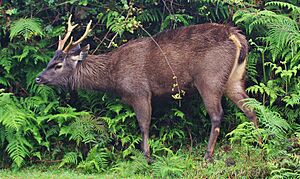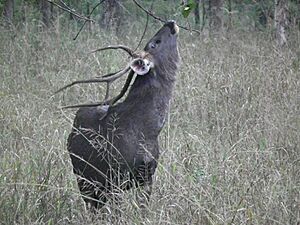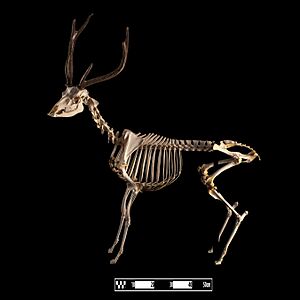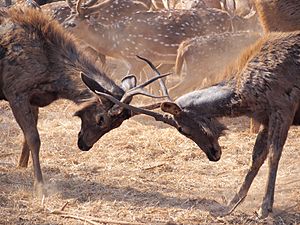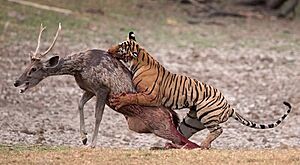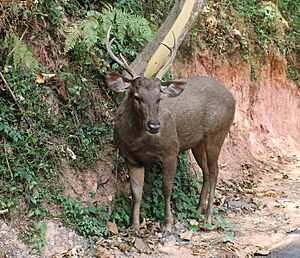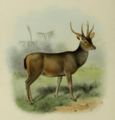Sambar deer facts for kids
Quick facts for kids Sambar |
|
|---|---|
 |
|
| Stag | |
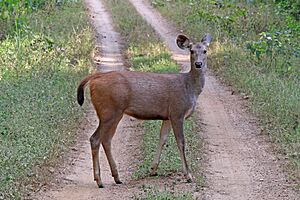 |
|
| Hind both R. u. unicolor in Kanha National Park, Madhya Pradesh, India |
|
| Conservation status | |
| Scientific classification | |
 |
|
| Range of the sambar | |
| Synonyms | |
|
The sambar (Rusa unicolor) is a very large type of deer. It lives in places like India, South China, and Southeast Asia. Since 2008, it has been listed as a vulnerable species, which means its numbers are going down. This is mainly because of too much hunting and changes to its home.
Sometimes, the name "sambar" is also used for other deer, like the Philippine deer (also called "Philippine sambar") and the Javan rusa (called "Sunda sambar").
Contents
About Sambar Deer History
Scientists have studied the genes of sambar deer. They think the closest living relative to the sambar is the Javan rusa, which lives in Indonesia. This makes sense because sambar and Javan rusa can still have babies together that can also have their own babies.
Old sambar deer bones have been found from a time called the early Pleistocene period. This was a very long time ago! These old deer looked a lot like even older deer from the Pliocene period. It's thought that the sambar deer first appeared in the warm, tropical parts of southern Asia. From there, they slowly spread out to all the places they live today.
Sambar Deer Types
There are different types, or subspecies, of sambar deer. The ones in India and Sri Lanka are the biggest. They also have the largest antlers compared to their body size. The sambar deer from South China and mainland Southeast Asia are usually the second biggest.
The sambar deer living in the Malay Peninsula and Sumatra, and on the island of Borneo, seem to have the smallest antlers compared to their body size. The smallest type of sambar deer is the Formosan sambar, which lives in Taiwan.
Today, scientists recognize seven main types of sambar deer.
What Sambar Deer Look Like
Sambar deer can look very different depending on where they live. Their size can also change a lot. This used to make it confusing for scientists to tell them apart!
Generally, they stand about 102 to 160 centimeters (about 3 to 5 feet) tall at the shoulder. They can weigh anywhere from 100 to 350 kilograms (about 220 to 770 pounds). Some very large ones can even weigh up to 546 kilograms (about 1,200 pounds)! Their body length, not counting the tail, is about 1.6 to 2.7 meters (about 5 to 9 feet). Their tail is shorter, about 22 to 35 centimeters (about 9 to 14 inches) long.
Deer from the western parts of their range tend to be bigger than those from the east. Female sambar deer are also smaller than males. Among all living deer, only the moose and the elk can grow larger than the sambar.
The males have large, rough antlers. These antlers usually have three points, or "tines," on each side. The antlers can grow up to 110 centimeters (about 43 inches) long on adult males. Like most deer, only the males grow antlers.
Their shaggy fur can be yellowish-brown to dark gray. It's usually one solid color. However, some types of sambar have chestnut-colored marks on their back end and belly. Sambar deer also have a small, thick mane, which is more noticeable on males. Their tail is quite long for a deer. It's usually black on top and whitish underneath.
Adult male sambar and females who are pregnant or feeding their babies have a strange, hairless, reddish spot on the underside of their throats. Sometimes, a white liquid comes out of it. Scientists think it's a special gland.
Where Sambar Deer Live
Sambar deer live in many parts of South Asia, including the southern slopes of the Himalayas in Nepal, Bhutan, and India. They also live in mainland Southeast Asia, like Burma, Thailand, Indochina, the Malay Peninsula, and the islands of Sumatra and Borneo in Indonesia. You can also find them in Taiwan and South China, including Hainan.
In some high places, like the Himalayan foothills, Myanmar, Sri Lanka, and eastern Taiwan, they can live up to 3,500 meters (about 11,500 feet) high. They like to live in different kinds of forests, from warm, dry forests to wet rainforests. They usually stay close to water. Recently, in 2023, sambar deer were seen back in Singapore. It's thought they came from zoos after being gone from the island for a long time.
Sambar deer prefer to hide in thick bushes and tall grasses. The exact type of plants they like depends on where they live. How much space they need also changes a lot. In India, males might use an area of 1,500 hectares (about 3,700 acres), while females use about 300 hectares (about 740 acres).
Sambar Deer Behavior and Lifestyle

Sambar deer are most active at night or during twilight (dawn and dusk). Male sambar deer usually live alone for most of the year. Female sambar deer live in small groups of up to 16 deer. However, in some places, a group might only have three or four deer. This group usually includes an adult female, her youngest baby, and maybe another younger female. This is a bit unusual for deer, as most deer live in much bigger groups.
They often gather near water and are good swimmers. Like most deer, sambar are usually quiet. But if they get scared, adult sambar can scream or make short, high-pitched sounds. They mostly talk to each other by leaving their scent marks and by stamping their feet.
Sambar deer eat many different plants. They munch on grasses, leaves, twigs, fruits, and water plants. What they eat depends on what's available in their local area. They also eat many kinds of bushes and trees.
In protected areas like national parks in India, Sri Lanka, and Thailand, many sambar deer can be seen together in large groups. In Taiwan, sambar deer are sometimes raised on farms. People value their antlers, which they shed every year in April or May. These antlers are used to make handles for knives and handguns.
Sambar deer can stand on their back legs, which is quite unusual for a deer! Males do this to rub their antlers on tree branches above them. Even though female sambar don't have antlers, they are very good at protecting their young from most predators. This is also quite rare for deer. If a group of wild dogs, like dholes, attacks them, a sambar will lower its head, raise its mane, and kick at the dogs. Sambar deer prefer to fight predators in shallow water. Several sambar might stand together, touching their backs, and make loud noises at the dogs to scare them away. When they sense danger, a sambar will stamp its feet and make a loud, ringing call.
Sambar deer are a favorite meal for tigers and Asiatic lions. In India, sambar deer make up almost half of what Bengal tigers eat. Some people even say that tigers can copy the sound of a sambar to trick them when hunting! Crocodiles, especially mugger crocodiles and saltwater crocodiles, also hunt sambar. Leopards and dholes usually hunt only young or sick deer, but they can attack healthy adult sambar too.
Reproduction and Life Cycle
Sambar deer can mate and have babies all year round, but most births happen during certain seasons. A female deer is ready to mate for about 18 days. The male deer will claim an area to attract females. He doesn't gather a group of females like some other deer. The male will stomp the ground, making a bare spot, and often roll in the mud. This might make his fur look darker, which could attract females. Even though they can make a loud, rough bellow, male deer during mating season are usually not very noisy.
Big, strong male deer will protect their areas. Smaller males might stay nearby and form alliances with the dominant male by sparring (play fighting). When male sambar fight with rivals, they lock antlers and push, just like other deer. But something special about them is that they sometimes stand on their back legs and clash downwards into each other, like a goat-antelope. Female sambar also fight on their back legs and use their front legs to hit each other's heads.
Mating is more about forming a bond than males calling out loudly. Females will move around different male territories to find a mate.
A female sambar deer is pregnant for about 8 months. Usually, only one baby, called a calf, is born at a time. But sometimes, twins can be born, though this is rare (only about 2% of births). When they are born, calves weigh about 5 to 8 kilograms (about 11 to 18 pounds). They usually don't have spots, but some types of sambar might have light spots that disappear soon after birth.
Young sambar calves start eating solid food when they are 5 to 14 days old. After one month, they start to "ruminate," which means they chew their food again after swallowing it, like cows do. Sambar deer have lived up to 28 years in zoos, but in the wild, they usually live no more than 12 years.
Sambar Deer in New Places
Sambar deer have been brought to other parts of the world by people, including Australia, New Zealand, and the United States. When an animal is brought to a new place where it doesn't naturally live, it's called an "introduced species."
Australia
In Australia, hunting sambar deer is a popular sport. Hunters like to get large antlers as trophies. However, too many sambar deer can harm native plants, and some plant species are even in danger of disappearing because of them.
Sambar deer were first brought to Victoria, Australia, in the 1860s. They quickly got used to the new environment and spread into the high country. By 2017, there were an estimated 750,000 to one million sambar deer in Victoria! They are now found along Australia's northern and eastern coasts.
In Victoria, sambar deer are listed as a threat to biodiversity. This means they reduce the number of native plant species. More than 60 plant species are directly or indirectly threatened by sambar deer in Victoria.
Adult male sambar can damage plants a lot. They might break off most branches on some bushes. They can also strip the bark off trees by rubbing their antlers on them. They also eat young plants, fruits, or seeds. They leave scrape marks on trees to show their territory.
The number of sambar deer has grown steadily in New South Wales and Victoria. They have even been seen on many southern beaches and near the outer parts of Melbourne.
There's a big discussion about how to manage them. Groups that want to protect nature believe the harm they do to the environment is too great. Hunting groups disagree and want to keep sambar populations healthy for future hunting. Sambar are protected game animals in Victoria and New South Wales, so you need a special license to hunt them. However, landowners can now remove problem deer on their private property without a special license. In other Australian states, they are considered a pest and can be hunted anytime without limits. Environmental groups want them to be called a "feral species" everywhere because their numbers are growing so fast and they harm native plants and animals.
In 2008–2009, hunters removed 35,000 sambar deer from public land in Victoria. But to stop the population from growing, about 40% of the deer need to be removed each year.
New Zealand
In New Zealand, sambar deer live along the coast and in valleys in certain areas. Until recently, they were protected. But now, the Department of Conservation has removed hunting rules for them, so they can be hunted all year round.
United States
Sambar deer were brought to St. Vincent Island, Florida, in 1908. By the 1950s, their numbers grew to about 50 deer. White-tailed deer also live on St. Vincent Island. However, white-tailed deer live in the higher areas, while sambar mostly live in the lowlands and wet areas. To make sure the sambar population doesn't harm the native white-tailed deer, hunting permits have been given out since 1987 to control their numbers. Each year, about 130 permits are offered for a three-day hunt. This keeps the sambar population at about 70–100 deer. They don't form large herds but are seen in groups of four or five, which might be family groups.
Between 1930 and 1941, sambar deer were also brought to Texas along with other large animals from other countries. Many of these "exotic game" animals are found on ranches in Texas.
See also
Images for kids



